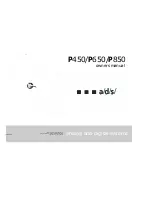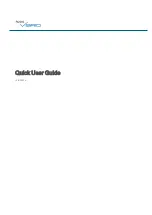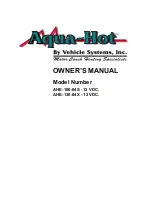
8
9
Installation Steps and Start-Up Procedures, Cont.
Step 2
Step 3
Step 4
Step 5
Step 6
Step 7
Turn Off Water Supply
A.
Turn off the water supply.
B.
Open the hot and cold water taps to depressurize the lines.
Connect Water Lines
A.
Connect water lines in compliance with all state and local, building, plumbing, and electrical codes.
Connect the Brine Tank
A.
Connect the brine tank to the main control valve with the flexible 3/8-inch poly tube included with the
appliance.
Connect Gravity Overflow Connections
The overflow line drains away excess water should the tank fill with too much water or the appliance
malfunction.
A.
Check that each overflow elbow is in the down position.
B.
Connect 1/2-inch I.D. tubing (size cannot be reduced) between the overflow fitting and a floor drain,
laundry tub, or other suitable waste receptor. This tubing is not supplied with the appliance. Ensure that
the overflow line ends at a drain that is at least 3 inches (8 cm) lower than the bottom of the overflow
fitting. Maintain a minimum 2-inch (5 cm) air gap between the overflow line and the flood level rim of the
waste receptor to prevent back siphoning. The gravity line cannot be run overhead.
Connect Drain Line
The drain line carries away the backwash water as part of the regeneration cycle.
A.
Connect the drain line to the drain end cap with a minimum 1/2-inch I.D. tubing (not supplied). The size
cannot be reduced.
Note:
If the drain line is 25 feet (7.6 meters) or longer, increase the drain line to 3/4-inch I.D. The end of
the drain line must be equal to or lower in height than the control valve.
Caution:
The drain line must not be kinked, crimped, or restricted in any way.
B.
Route the drain line to a floor drain, laundry tub, or other suitable waste receptor. Maintain the same
2-inch (5 cm) air gap as with the overflow line. This drain line should make the shortest run to the
suitable drain.
C.
The drain line may be elevated up to 8 feet (2.4 meters) from the discharge on the appliance as long as
the water pressure in your system is 40 psi (2.8 bar) or more.
Flush Lines
A.
Place the appliance in the Bypass position.
B.
Turn on the main water supply.
C.
Open the nearest cold water faucet to flush the plumbing of any excess soldering flux, air, or any other
foreign material.
Installation Steps and Start-Up Procedures
Step 1
Prepare the Placement Area
A.
Make sure the placement area is clean.
B.
Turn off the electricity and water supply to the water heater. For gas water heaters, turn the gas cock to
“Pilot.”
C.
Examine the inlet plumbing to ensure that the pipe is not plugged with lime, iron, or any other substance.
Clean or replace plugged plumbing.
D.
Make sure the inlet/outlet and drain connections meet the applicable state and local codes.
E.
Check the arrows on the bypass valve to ensure that the water flows in the proper direction.
See
Bypass Valve
.
Caution:
Do not plumb the appliance in backward.
F.
Place the appliance in the desired location using Figure 1 as a guide. The diagram in Figure 1 applies to
basement, slab, crawl space, and outside installations.
G.
For most installations, install the appliance after the pressure tank and any water filter appliance or
water meter and before the water heater unless otherwise recommended. When installing any additional
filters, such as a carbon filter for well water, place the filter after any water conditioning appliance unless
otherwise recommended.
Water Heaters:
If less than 10 feet (3 meters) of pipe connects the water treatment appliance(s) to the
water heater, install a check valve between the water treatment appliance and the water heater as close
to the water heater as possible. Ensure that the water heater has an adequately rated temperature and
pressure safety relief valve.
H.
For outside installations, the appliance should be enclosed so it is protected from the weather.
Figure 1: Appliance Placement






































